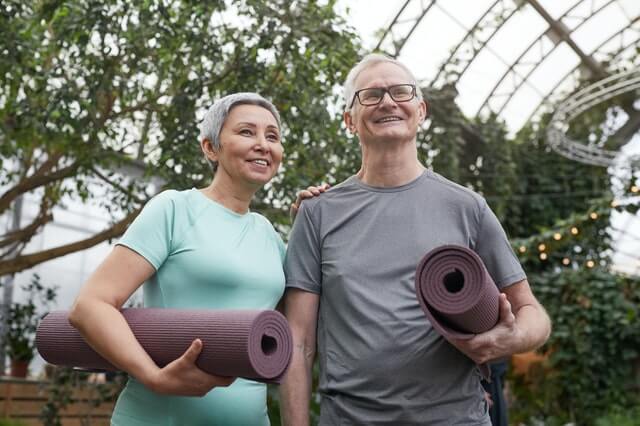Yoga is an ancient practice that offers benefits to both the body and mind. More than 21% of people practicing yoga in the U.S. are seniors, and that percentage is climbing. Yoga is a form of physical fitness that’s conducive to multiple skill levels and is popular among people of all ages. While practicing any form of physical fitness as a senior requires some extra attention to safety (and many people may even want to consult their doctor before beginning any type of physical fitness regimen), yoga is the type of activity that seniors can improve at in their own time and at their own pace.
Keep in mind that there are many different types of yoga. Some, which we’ll outline here, are particularly popular with seniors. Regardless of what type(s) you choose to try, you can expect to enjoy both physical and mental health benefits in time. Here, we’ll explore the benefits of yoga to seniors and provide an overview of some senior-friendly yoga practices and how to get started.
Benefits of yoga for seniors
Yoga offers seniors many different rewards that can enhance their overall well-being. In fact, many yoga experts suggest that we’re never too old to reap the rewards of this mind-and-body practice. With its stretching and strengthening postures complemented by its focus on deep breathing and relaxation, yoga can offer a surprising range of benefits that include:
Enhanced balance, flexibility, mobility, and strength
According to the American Osteopathic Association, yoga can improve balance, flexibility, mobility, and strength. When seniors practice yoga, they stretch and flex various muscle groups. The practice makes these muscles stronger as well as more flexible. The result is that seniors experience better balance and can move around better. If you have joint issues, you can also take Hemp Magic Plus regularly in addition to your yoga practice to ease joint discomfort and boost your mobility.
Strengthened bones
Per some researchers at Harvard Health, medical research suggests that yoga can improve bone density, which means stronger bones. According to recent studies, yoga may be able to help ward off osteoporosis. Although yoga may be recommended for people with osteoporosis, there isn’t a consensus among doctors about which poses are safest for compromised bone mass. If you have osteoporosis, ask your doctor about any yoga poses that you should avoid.
Improved sleeping habits
According to Harvard Health, more than half of people who practice yoga report that they experience better sleep. Yoga can alleviate tension and stress, which can detract from sleep. Exercise, in general, is associated with improved sleep; and yoga appears to offer this benefit to people of any age.
Reduce aches and pains
Although yoga isn’t a cure for pain or the conditions that trigger it, the practice is known to alleviate aches and pains. One of the ways it does this is by reducing inflammation. Because yoga improves flexibility and mobility, it can help minimize pain for seniors when they’re on the go.
Lowers the risk of depression
More than 2 million people aged 65 and older suffer from some form of depression. Chronic health conditions, loss of a spouse, reduced opportunities to socialize, rising healthcare, and living costs—these are just some of the risk factors associated with depression among seniors. Yoga can help restore emotional balance with its focus on mindfulness. Seniors feel more energized after practicing yoga, which can improve their mental well-being. Incorporating whole hemp extract, like GreenPower, into your daily supplement regimen can also help you improve your mental well-being.
Best types of yoga for seniors
There are more than 100 types of yoga, but some are better for seniors than others. Here, we’ll highlight a few yoga practices that are popular with seniors today.
Chair yoga
Chair yoga is a general umbrella term for yoga poses that rely on the use of a chair. The chair provides support, which seniors may wish to rely on when practicing various poses safely. In fact, many people who may struggle to stand or walk may still practice yoga using a chair. People suffering from some neurological conditions, obesity, or decreased mobility may find that chair yoga is more accessible than other forms of the practice.
Hatha yoga
Hatha yoga has been dubbed a ‘catch-all’ form because it features a wide range of general yoga practices focused on breathing techniques and stretches. It’s a great option for seniors who are looking for a well-balanced introduction to yoga. Hatha yoga is generally slow-paced and includes both sitting and standing poses.
Iyengar yoga
Known for its precise and methodical techniques, Iyengar yoga is focused on proper form. To that end, practitioners are frequently encouraged to use various props like incline boards or blocks to achieve the correct posture. The props offer some support, which can be especially helpful for seniors who may find it difficult to achieve these postures on their own because of conditions like arthritis.
Kundalini
Kundalini yoga has a deeply spiritual aspect that is appealing to many seniors. Known as the ‘yoga of awareness,’ kundalini focuses on achieving mindfulness and full mental awareness. While physical stretches and poses accompany the practice, they aren’t the primary focus of this form of yoga.
Restorative yoga
Seniors who want to improve their relaxation and reduce stress are typically encouraged to try restorative yoga. This form of yoga is slow-paced and features a strong meditative component. Poses can be long—up to ten minutes in length, but props that provide support are commonplace in restorative yoga. Many seniors searching for an exercise that’s not overly physical might enjoy this calming form of yoga.
Before you get started
Seniors interested in embarking on a yoga regimen should prepare well first. This section will cover the steps you should take before you get started with any type of yoga practice.
Evaluate your physical condition
Before starting yoga, talk to your healthcare provider. Physical fitness is generally recommended for seniors, but each person is different. Some seniors have certain health conditions or limitations that may make one form of yoga preferable than another. By getting a health evaluation and your doctor’s recommendations, you’ll be able to make a more informed decision about what type of yoga is best for you.
Gather your gear
If you’re practicing yoga at a yoga studio or community center, some gear, like blocks or incline boards, may be supplied. However, you should plan to get your own yoga mat and comfortable clothing conducive to yoga practice. If you’re practicing yoga at home, you may want to purchase your own props or additional gear, depending on the type of yoga you choose.
Select a qualified teacher
Seniors should search for a qualified teacher offering the type of yoga instruction they’re interested in practicing. Preferably, look for a yoga instructor that offers classes that are specifically designed with seniors in mind. Many community centers offer yoga classes, but there are also private yoga instructors in most cities today.
Learn about yoga
Do some research to determine what type of yoga is ideal for you. Depending on your physical or psychological needs, certain types of yoga may be more beneficial for you than others. If you’re struggling with stress or mental health issues like anxiety or depression, you’ll want to look for a form of yoga that features a strong focus on emotional balance and health. Conversely, you may be in search of a type of yoga that intensely focuses on flexibility. By reading about the different types of yoga, you’ll be able to select one that’s right for your needs and goals.
Practice breathing exercises
Deep breathing is an essential feature of yoga, generally speaking. You can prepare for yoga sessions by practicing breathing exercises. There are lots of books and video tutorials about yoga breathing techniques and other yoga practices that may help you get started with whatever type of yoga form you choose.
Start slow
As a senior, it’s vital to begin any new form of physical fitness with caution to prevent injury. Remember, you’re not only practicing physical fitness; you’re also learning new skills and techniques. Give yourself time to learn each new pose and progress with gentleness for best results.
Take breaks when you need them
It’s important to take breaks during yoga sessions when you need to. In fact, when starting a new class, you may only be able to participate for part of the time. That’s okay because you’ll build your skills and may eventually require fewer breaks. Don’t over-exert yourself, or you could risk injury. Remember, you can still achieve the benefits of yoga by practicing it at your own pace and taking breaks as needed.
Increasing numbers of seniors are gravitating to the practice of yoga. After taking classes with proper instruction, you may be ready to practice some yoga at home or even when you’re traveling. Yoga classes are offered all over the world—in private studios as well as in public parks. Once your healthcare provider greenlights you for yoga practice, you’ll have lots of options to choose from. Take time to research the different forms of yoga in more depth so you can choose the best type for you.






